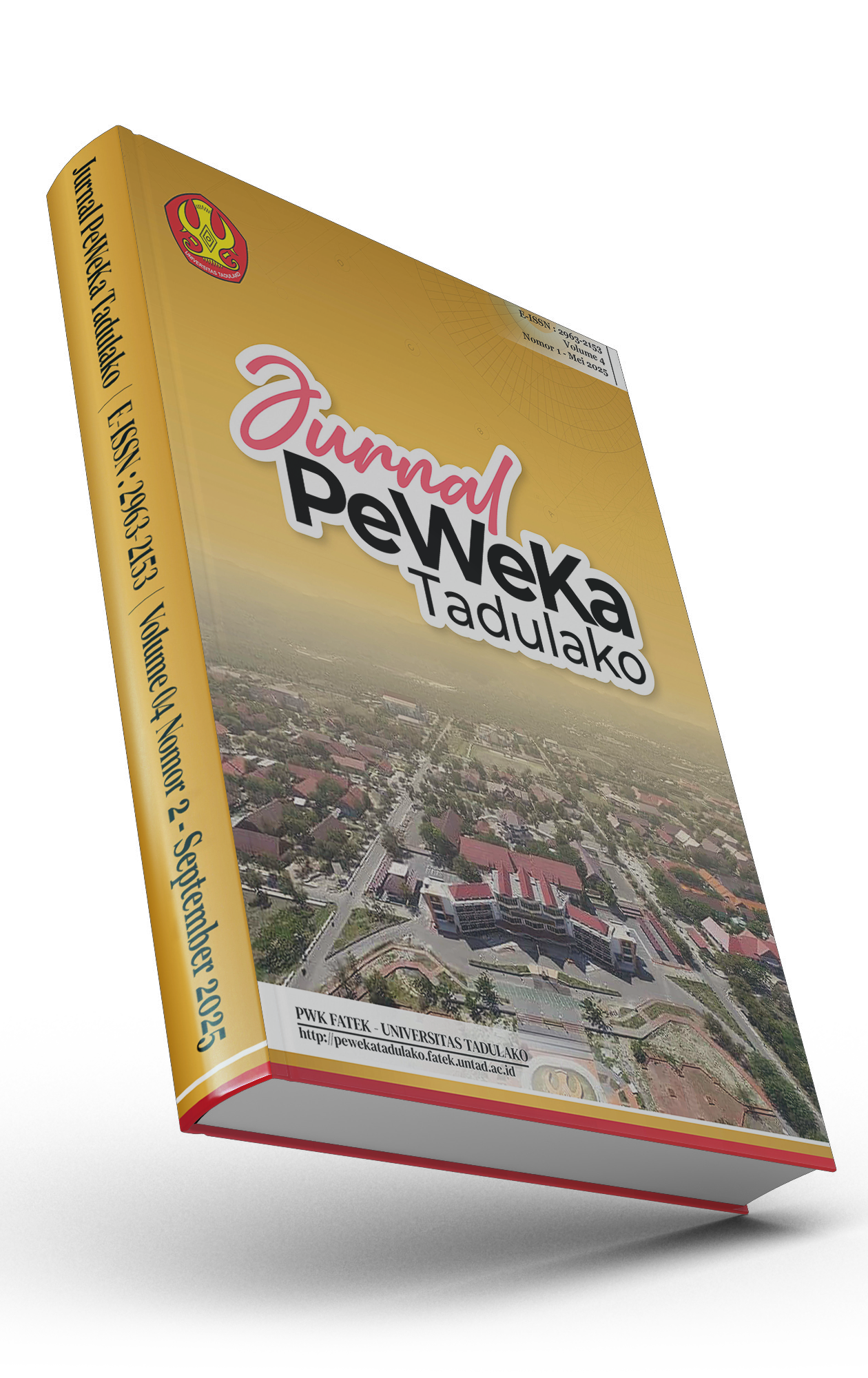Ketersediaan dan Kebutuhan RTH Publik sebagai Infrastruktur Evakuasi Bencana di Kawasan Perkotaan: Studi Kasus Kecamatan Palu Timur, Kota Palu
DOI:
https://doi.org/10.22487/peweka.v4i2.65Keywords:
Public Green Open Space (GOS), disaster evacuation infrastructure, urban resilience, East PaluAbstract
The demand for space in urban areas is significant due to population and economic growth. As a result, the need for space has increased sharply. The most obvious impact is the expansion of the existence of Green Open Space (GOS). This study aims to assess the availability of public GOS in East Palu District by examining its proportion relative to the total land area and population, its potential role in disaster evacuation, and the identification of land suitable for future development. A descriptive quantitative method is employed, referencing national regulations such as Law No. 26 of 2007 and Ministry of Public Works Regulation No. 5 of 2008. Geographic Information Systems (GIS) were used for land mapping analysis. The findings indicate that in 2023, East Palu has 44.11 hectares of public GOS. With the district covering 970 hectares, the ideal allocation for green spaces is 149.9 hectares (20%). Given a population of 44,491, the required GOS amounts to 889.82 hectares, revealing a significant shortfall of 845.71 hectares. Furthermore, the identification of only 44.85 hectares of land as suitable for further GOS development remains insufficient. GOS is essential not only for aesthetics and recreation but also as crucial infrastructure for enhancing urban resilience during disasters. It is therefore vital for agencies involved in land management, urban planning, and disaster response to collaborate, ensuring that public GOS is prioritized in sustainable city planning.
References
Badan Nasional Penanggulangan Bencana. (2008). Peraturan Kepala Badan Nasional Penanggulangan Bencana Nomor 7 Tahun 2008 tentang pedoman tata cara pemberian bantuan pemenuhan kebutuhan dasar.
Bappeda Kota Palu. (2022). Renstra Kecamatan Palu Timur 2021–2026. Pemerintah Kota Palu.
Bilgili, B. C., & Gökyer, E. (2012). Urban green space system planning. In M. Ozyavuz (Ed.), Landscape planning (pp. 51–65). https: doi.org/10.5772/45877
BPS Kota Palu. (2024a). Kecamatan Palu Timur dalam angka 2024.
BPS Kota Palu. (2024b). Kota Palu dalam angka 2024.
Departemen Pekerjaan Umum. (2018). Peraturan Menteri Pekerjaan Umum dan Perumahan Rakyat Nomor 5 Tahun 2008 tentang Pedoman Penyediaan dan Pemanfaatan Ruang Terbuka Hijau di Kawasan Perkotaan.
Fadhila, C. H., Murtilaksono, K., & Munibah, K. (2019). Arahan pemenuhan ruang terbuka hijau Kota Banda Aceh. Tataloka, 21(1), https: doi.org/10.14710/tataloka.21.1.180-191
Gosal, K. G. T., Wardana, T., & Firmansyah, A. M. (2024). Implementasi kebijakan ruang terbuka hijau (RTH) dalam tata kelola ruang di Kota Palu. JPS: Journal of Publicness Studies, 1(4), 59– 66. https://doi.org/10.5281/jps.v1i4.1627
Graziano, M. P., Deguire, A. K., & Surasinghe, T. D. (2022). Riparian buffers as a critical landscape feature: Insights for riverscape conservation and policy renovations. Diversity, 14(3), Article 171. https://doi.org/10.3390/d14030171
Hidayah, R., Sativa, S., & H., S. (2021). Strategi pemenuhan ruang terbuka hijau publik di Kota Yogyakarta. INERSIA: Informasi dan Ekspose Hasil Riset Teknik Sipil dan Arsitektur, 17(1), 11– 18. https://doi.org/10.21831/inersia.v17i1.40765
Jayakody, R. R. J. C., Amaratunga, D., & Haigh, R. (2018). Plan and design public open spaces incorporating disaster management strategies with sustainable development strategies: A literature synthesis. MATEC Web of Conferences, 229, Article 02007. https://doi.org/10.1051/matecconf/201822904001
Kementerian Agraria dan Tata Ruang/Badan Pertanahan Nasional. (2022). Peraturan Menteri Agraria dan Tata Ruang/Kepala Badan Pertanahan Nasional Nomor 14 Tahun 2022 tentang Penyediaan dan Pemanfaatan Ruang Terbuka Hijau.
Marshall, N. G., & Corkery, L. F. (2018). Urban parks and open space: Underpinning a city’s future resilience. In State of Australian Cities Conference 2017, Adelaide, Australia, 28–30 November 2017. https://doi.org/10.4225/50/5b2f28d76eecd
Martin, J. G. C., Scolobig, A., Linnerooth-Bayer, J., Irshaid, J., Aguilera Rodriguez, J. J., Fresolone- Caparrós, A., & Oen, A. (2025). The nature-based solution implementation gap: A review of nature-based solution governance barriers and enablers. Journal of Environmental Management, 388, 126007. https:/ doi.org/10.1016/j.jenvman.2025.126007
Meerow, S., & Newell, J. P. (2017). Spatial planning for multifunctional green infrastructure: Growing resilience in Detroit. Landscape and Urban Planning, 159, 62–75. https://doi.org/10.1016/j.landurbplan.2016.10.005
M’Ikiugu, M. M., Kinoshita, I., & Tashiro, Y. (2012). Urban green space analysis and identification of its potential expansion areas. Procedia – Social and Behavioural Sciences, 35, 449–458. https://doi.org/10.1016/j.sbspro.2012.02.110
Mirsafa, M., Castaldo, A. G., & de Oliveira, F. L. (2025). Enabling nature-based solutions for climate adaptation in cities of the Global South: Planning dimensions and cross-cutting pathways for implementation. Environment, Development and Sustainability. Advance online publication. https://doi.org/10.1007/s10668-025-06256-7
Müller-Jökel, R. (2004, May 22–27). Land readjustment – A win-win strategy for sustainable urban development. Paper presented at FIG Working Week 2004: The Olympic Spirit in Surveying, Intercontinental Athenaeum Athens, Athens, Greece. https://www.fig.net/resources/proceedings fig_proceedings/athens/papers/ts14/TS14_3_MullerJokel.pdf
Nurfadhil, R., & Zain, A. F. M. (2024). Evaluasi ketersediaan ruang terbuka hijau dan penerapan konsep kota hijau di Provinsi DKI Jakarta. Journal of Regional and Rural Development Planning (Jurnal Perencanaan Pembangunan Wilayah dan Perdesaan), 8(1), 76–95. https://doi.org/10.29244 jp2wd.2024.8.1.76-95
Pemerintah Kota Palu. (2021). Peraturan Daerah Kota Palu Nomor 2 Tahun 2021 tentang Rencana Tata Ruang Wilayah Tahun 2021–2041.
Pemerintah Kota Palu. (2023). Peraturan Wali Kota Palu Nomor 1 Tahun 2023 tentang Rencana Detail Tata Ruang Tahun 2023–2043.
Pratiwi, P., & Rahman, B. (2025). Potensi pemenuhan ruang terbuka hijau (RTH) berdasarkan guna lahan. Jurnal Kajian Ruang, 5(1), Maret 2025. https://doi.org/10.30659/jkr.v5i1.44521
Quistarini, A., Rostian, T. S., & Krisantia, I. (2019). Analisis kebutuhan ruang terbuka hijau publik berdasarkan proyeksi penduduk pada Kecamatan Tangerang. Prosiding Seminar Nasional Cendekiawan 2019: Teknologi dan Sains, 5, 26–32. https://doi.org/10.25105/semnas.v0i0.5731
Rabiatul, S. R. W., Takwim, S., Abdi, A. P., Rasdiana, & Wahyuningsih, T. (2025). Analisis kesiapan kebijakan tata ruang Kota Palu dalam mendukung agenda SDG 11 (Kota Berkelanjutan). Jurnal PeWeKa Tadulako, 4(1), 18–35. https://doi.org/10.22487/peweka.v4i1.49
Sari, N. W., Sulandari, S., & Lituhayu, D. (2014). Mitigasi gempa dan tsunami di Kota Padang. Journal of Public Policy and Management Review, 3(2), 191–201. https://doi.org/10.14710/jppmr.v3i2.5127
Segura, R., Krayenhoff, E. S., Martilli, A., Badia, A., Estruch, C., Ventura, S., & Villalba, G. (2022). How do street trees affect urban temperatures and radiation exchange? Observations and numerical evaluation in a highly compact city. Urban Climate, 46, Article 101288. https://doi.org/10.1016/j.uclim.2022.101288
Sharma, R., Pradhan, L., Kumari, M., & Bhattacharya, P. (2022). Urban green space planning and development in urban cities using geospatial technology: A case study of Noida. Journal of Landscape Ecology (Czech Republic), 15(1), 27–46. https://doi.org/10.2478/jlecol-2022-
Sphere Association. (2018). The Sphere handbook: Humanitarian charter and minimum standards in humanitarian response (4th ed.). Practical Action Publishing. https://spherestandards.org/wp-content/uploads/Sphere-Handbook-2018-EN.pdf
Thompson, C. W. (2002). Urban open space in the 21st century. Landscape and Urban Planning, 60(2), 59–72. https://doi.org/10.1016/S0169-2046(02)00059-2
UNHCR. (2025, January 30). Emergency shelter solutions and standards. Emergency Handbook. https://emergency.unhcr.org/
Watson, C. S., Elliott, J. R., Ebmeier, S. K., Vásquez, M. A., Zapata, C., Bonilla-Bedoya, S., Cubillo, P., Orbe, D. F., Córdova, M., Menoscal, J., & Sevilla, E. (2022). Enhancing disaster risk resilience using greenspace in urbanising Quito, Ecuador. Natural Hazards and Earth System Sciences, 22(5), 1699–1721. https://doi.org/10.5194/nhess-22-1699-2022
Downloads
Published
How to Cite
Issue
Section
License
Copyright (c) 2025 Iwan Setiawan Basri, Rosmiaty Arifin, Sarifuddin, Regina Excelsia Pelealu

This work is licensed under a Creative Commons Attribution-ShareAlike 4.0 International License.







